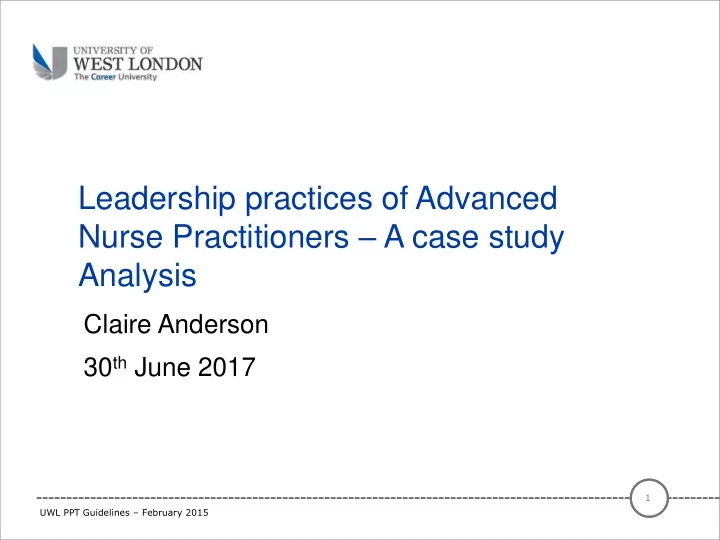

Leadership practices of Advanced Nurse Practitioners – A case study Analysis Claire Anderson 30 th June 2017 1 UWL PPT Guidelines – February 2015
Aim To explore the expressed views on leadership of the participants
Background • Nurses have not historically been seen as leaders
Advanced Practice: Four Pillars 4 UWL PPT Guidelines - Version 2 - February 2015
Social Constructionist • We were interested in their views as a community and so our underpinning theoretical perspective acknowledged this. • An intersubjective reality created by discourse between individuals and which constructs their identity within the social environment.
Methodology • Case exploration is an established approach used within clinical healthcare practice. • A combined instrumental and collective case study
Methods • Eight participants were interviewed • The data was initially analysed individually and then compared with the other participants; employing a structured thematic analysis.
Participant ANPs • DGH Male 2 years as ANP • Community Specialist Female 3 years as ANP • General Practice Female 5 years as ANP • General Practice Female 18 years as NP/ANP • General Practice Female 25 years as NP/ANP • A&E Female 3 years as ANP • General Practice Male 10 years as ANP • A&E Male 2 years as ANP 8 UWL PPT Guidelines - Version 2 - February 2015
Placement on the leadership pyramid: • Leadership: Nature/Nurture: Confidence: Autonomy • I am the absolute, pinnacle leader. • I will lead, but I’m still very happy to do the basic. • You could take ten random people and teach them the same things about leadership but only one of them would be a really outstanding leader. • I have that knowledge to say and that confidence to say.
Motivating the team: • Leadership qualities: Role Model: Leading Others: Empowering Others: Communication: Resolving Conflict: Line Management: Support for you as a Leader • As well as offering leadership we’re nourishing leadership. • See me as somebody they can model themselves on. • Understanding people and understanding the way different people function. • So much easier to lead.. If they have the same values and beliefs. • They know how to manage services.. It’s a bit different to having real leadership qualities. • Listen to their feedback, take their ideas on board, try to involve people as much as possible ’.
Retreating to the safety of the nursing profession: Credibility • Credibility: Basic Nursing Care: Knowledge • You need credibility and that’s why I’ve got here because I can do the job. I can do the job really well. • You are actually doing the same but maybe you bring that extra knowledge in as well. • I just feel that my knowledge level is different and I probably see things differently.
Assumed and Accepted Medical Hierarchy: Doctors • Doctors: Disempowered • Sometimes for other professionals it’s quite hard to infiltrate. • They still know that I’m not a doctor. • It’s been three years of a battle, of people understanding what an ANP is. • You don’t have to be nominated as a leader .
ANP’s impact on patient outcomes: Managing Change • Managing Change: Networking: Save Money; Maintain Quality and Governance • People don’t cope with change very well. • That sort of networking really helps your confidence. • I think, particularly in the current climate, we’ve got lots of constraints on our work, financial constraints, we don’t have enough resources. • One goal is obviously governance for the patient. • There’s always someone above you putting pressure on you to achieve those targets.
Discussion • Nursing leading nurses
Discussion • Locus of Control
Value for money 16 UWL PPT Guidelines - Version 2 - February 2015
Discussion • Impact on patient outcomes
Limitations and recommendations • Small study; Single interview; Self-report • Applied and consistent leadership education • Longitudinal study • Wider geographical representation • Action research
Conclusion • Exemplary leadership • ‘challenge the process’
Recommend
More recommend